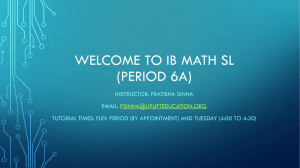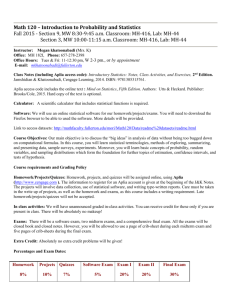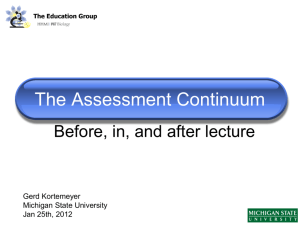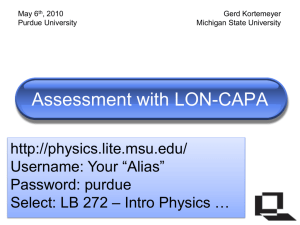Teaching Statement: Motivating Math Students
advertisement
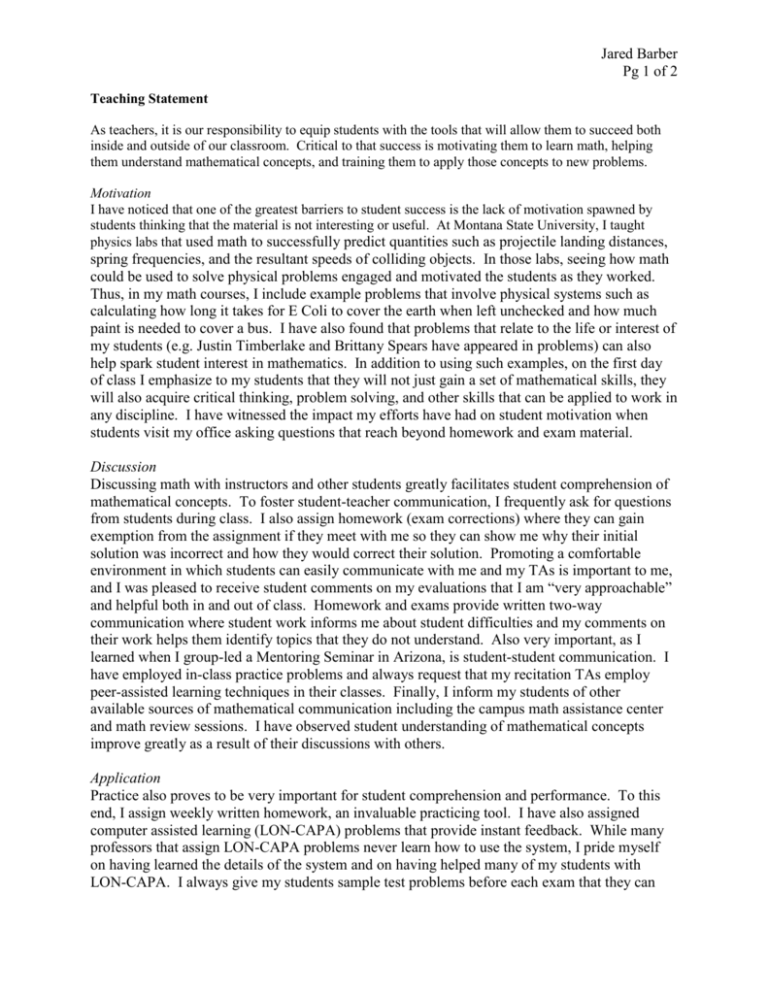
Jared Barber Pg 1 of 2 Teaching Statement As teachers, it is our responsibility to equip students with the tools that will allow them to succeed both inside and outside of our classroom. Critical to that success is motivating them to learn math, helping them understand mathematical concepts, and training them to apply those concepts to new problems. Motivation I have noticed that one of the greatest barriers to student success is the lack of motivation spawned by students thinking that the material is not interesting or useful. At Montana State University, I taught physics labs that used math to successfully predict quantities such as projectile landing distances, spring frequencies, and the resultant speeds of colliding objects. In those labs, seeing how math could be used to solve physical problems engaged and motivated the students as they worked. Thus, in my math courses, I include example problems that involve physical systems such as calculating how long it takes for E Coli to cover the earth when left unchecked and how much paint is needed to cover a bus. I have also found that problems that relate to the life or interest of my students (e.g. Justin Timberlake and Brittany Spears have appeared in problems) can also help spark student interest in mathematics. In addition to using such examples, on the first day of class I emphasize to my students that they will not just gain a set of mathematical skills, they will also acquire critical thinking, problem solving, and other skills that can be applied to work in any discipline. I have witnessed the impact my efforts have had on student motivation when students visit my office asking questions that reach beyond homework and exam material. Discussion Discussing math with instructors and other students greatly facilitates student comprehension of mathematical concepts. To foster student-teacher communication, I frequently ask for questions from students during class. I also assign homework (exam corrections) where they can gain exemption from the assignment if they meet with me so they can show me why their initial solution was incorrect and how they would correct their solution. Promoting a comfortable environment in which students can easily communicate with me and my TAs is important to me, and I was pleased to receive student comments on my evaluations that I am “very approachable” and helpful both in and out of class. Homework and exams provide written two-way communication where student work informs me about student difficulties and my comments on their work helps them identify topics that they do not understand. Also very important, as I learned when I group-led a Mentoring Seminar in Arizona, is student-student communication. I have employed in-class practice problems and always request that my recitation TAs employ peer-assisted learning techniques in their classes. Finally, I inform my students of other available sources of mathematical communication including the campus math assistance center and math review sessions. I have observed student understanding of mathematical concepts improve greatly as a result of their discussions with others. Application Practice also proves to be very important for student comprehension and performance. To this end, I assign weekly written homework, an invaluable practicing tool. I have also assigned computer assisted learning (LON-CAPA) problems that provide instant feedback. While many professors that assign LON-CAPA problems never learn how to use the system, I pride myself on having learned the details of the system and on having helped many of my students with LON-CAPA. I always give my students sample test problems before each exam that they can Jared Barber Pg 2 of 2 use for their studying. I often hold outside of class review sessions during which they can ask me their questions on the sample problems and exam material. Because the exams also offer a means for practicing and applying the techniques learned, I carefully craft my exams to evenly address each concept from class. Outside of the classroom, I have mentored three Complex Biological Systems Group REU students on projects relating to my research. I enjoy seeing my mentees discover specific ways in which mathematical modeling can yield insight into biological systems. As I have worked alongside students I have seen all these forms of practice, from homework to actually taking on a project, improve student understanding of mathematics and their ability to apply mathematics. Final Thoughts Overall, I believe that my teaching techniques have motivated my students to appreciate the power of mathematics and to find the great value in learning and applying the concepts and techniques taught in class. It is my sincere desire that the lessons they have learned from being in my class will help propel them to success in their eventual fields of expertise.




